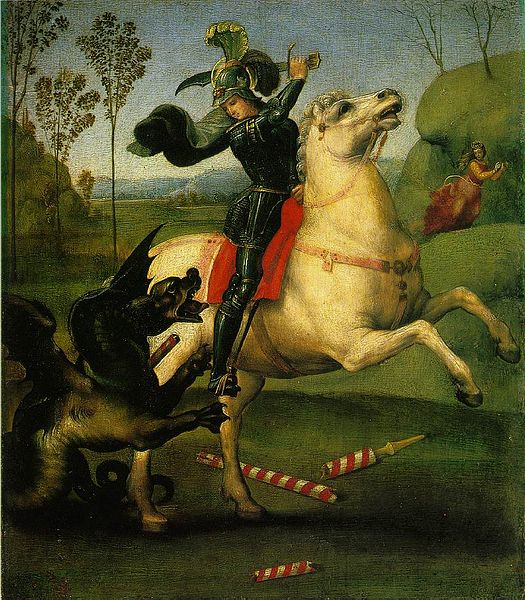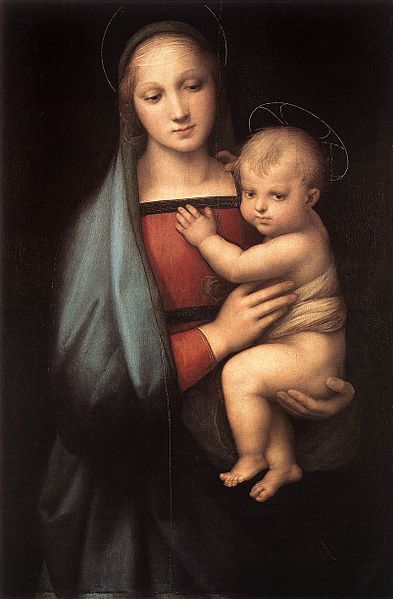settings
Anna Karenina vocabulary
13 Christianity and/or Biblical vocabulary words
help & settings
[x]
-
Raphael
-
► definition
Definition:[1483 - 1520]an Italian painter and architect of the High Renaissance. His work is admired for its clarity of form, ease of composition, and visual achievement of the Neoplatonic ideal of human grandeur. Together with Michelangelo and Leonardo da Vinci, he forms the traditional trinity of great masters of that period.Raphael was enormously productive, running an unusually large workshop and, despite his death at 37, leaving a large body of work.text from Wikipedia, licensed under Creative Commons - Attribution - Sharealike
 painting 1: St. George and the Dragon (1503)painting 2: The Granduca Madonna (1504)
painting 1: St. George and the Dragon (1503)painting 2: The Granduca Madonna (1504)
► uses
Uses:
the Duke had met Raphael on a vist to Rome and had been promised a painting by him. But Raphael refused to touch the Bacchanal. He had heard, he wrote, that the commission had also been offered to another painter, and he perferred therefore to do something else for the Duke, on another theme. For more than a year, Alfonso continued to urge the Bacchanal on Raphael, and Raphael continued to reject it. Finally, when it became obvious that his appeals were fruitless, Alfonso commissioned all three works from Titian.
Leo Tolstoy. Anna Karenina (1878)
Jay Williams. The World of Titian, p.83. Time-Life Books (1968)
---
He was fond of talking about Shakespeare, Raphael, Beethoven, of the significance of new schools of poetry and music, all of which were classified by him with very conspicuous consistency.
---
"They had well-known artists: Raphael and Monet and Picasso. But there were some we never heard of: Uccello and Velázquez."
Anita Hughes. Christmas in London, p.231 (2017)
---
I can still recall how lovely she looked, like a Raphael madonna.
V.C. Andrews. Flowers in the Attic, p.9 (1979)
---
This Copy was so perfect, that Julio Romano, who had been bred and taught by Raphael, and was one of the best Painters of Italy, took it for an Original; and would never have been undeceived, if one Vasari had not assured him, that it was but a Copy, which himself had seen made, and had not shew'd him certain marks, that were there put to discriminate it from the Original.
The Royal Society. Philosophical Transactions: Giving Some Accompt of the Present Undertakings, Studies,and Labours of the Ingenious in Many Considerable Parts of the World, volume I (1666)
---
But the paintings!—Kupris! Astarte! Astoreth!—a thousand and the same! And Rafaelle has beheld them! Yes, Rafaelle has been here, for did he not paint the—? and was he not consequently damned?
Edgar Allan Poe. The Works of Edgar Allan Poe — Volume 4: The Duc de L'Omelette (1832)
---
Mrs. Driffert’s visitors (always a little flurried by the sense that it was the kind of house in which one might be suddenly called upon to distinguish between a dry-point and an etching, or between Raphael Mengs and Raphael Sanzio) were not infrequently subjected to the Professor’s off-hand inquiry, “By-the-way, have you seen my Keniston?”
---
The several schools of the old masters were represented by a Madonna of Raphael, a Virgin of Leonardo da Vinci, a nymph of Corregio, a woman of Titan, an Adoration of Veronese, an Assumption of Murillo, a portrait of Holbein, a monk of Velasquez, a martyr of Ribera, a fair of Rubens, two Flemish landscapes of Teniers, three little "genre" pictures of Gerard Dow, Metsu, and Paul Potter, two specimens of Gericault and Prudhon, and some sea-pieces of Backhuysen and Vernet.
Jules Verne. Twenty Thousand Leagues under the Sea
